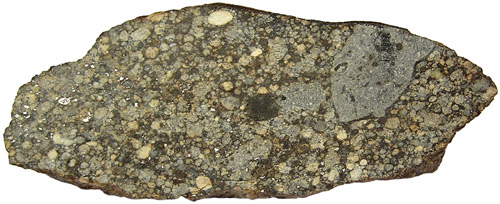


- Meteorites For Sale - Found A Meteorite? - Monthly Favourite - Meteorite Information - Classification List - Meteorite Collection - Media Centre - Home - Search - Site Map - Contact |
|
NWA 3099 The meteorite, NWA 3099 was found in North West Africa in 2003. This meteorite has been classified as a very rare intermediate chondrite; L/LL3. It also has been given a weathering level of just 1 and a very high shock rating of 4 which is not particularly evident. The Total Known Weight for this remarkable meteorite is a miniscule 179g which has been cut from a single stone into about a dozen slices. NWA 3099 displays has a beautifully coloured matrix full of crisp chondrules and many various other inclusions. The stone also has fresh black crust and flow lines in some areas. This specimen is part of the Meteorites Australia Collection and includes the following features:
Don't forget to check out the link at the bottom of this page for other L3 & LL3 Chondrites.
Further Reading
/ Theories by Bernd Pauli: While rare; it may be possible that this
meteorite contains Carbonaceous inclusions. A well-known example
is Krymka (LL3.1/S3) some slices of which include black
carbonaceous material, referred to as 'Mysterite'.
Interestingly, where there is Mysterite in the Krymka chondrite,
there is also abundant troilite in the matrix. There are also
graphite-bearing fragments and, again, these fragments contain a
high abundance of troilite and graphite.
Similarities & Differences - Other L3 & LL3 Chondrites -->
Click here to view the archive of the Monthly Favourites
|

.jpg)
.jpg)
